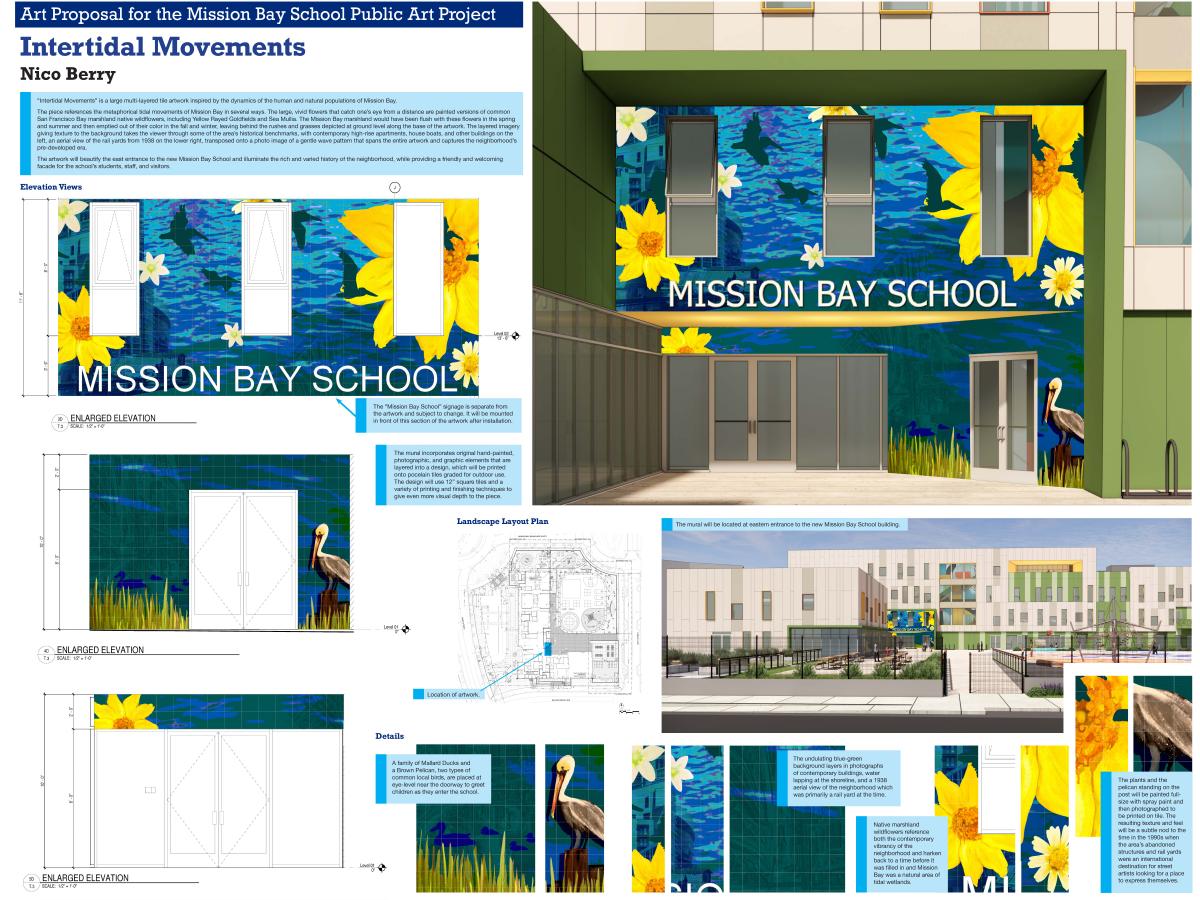 Intertidal Movements is a large multi-layered tile artwork inspired by the dynamics of the human and natural populations of Mission Bay. It will beautify the east entrance to the new Mission Bay School and illuminate the rich and varied history of the neighborhood, while providing a friendly and welcoming facade for the school’s students, staff, and visitors.
Intertidal Movements is a large multi-layered tile artwork inspired by the dynamics of the human and natural populations of Mission Bay. It will beautify the east entrance to the new Mission Bay School and illuminate the rich and varied history of the neighborhood, while providing a friendly and welcoming facade for the school’s students, staff, and visitors.
Built on what used to be marshland and shallow bay, what is now called the Mission Bay neighborhood used to be covered by marshlands and water that would rise and fall with the ocean tides. The wetlands were teeming with life that was largely displaced by landfill in the late 1800s. Railroads came in soon after, and the area was once again full, now with rail yards and commerce from the shipping industry. However, when the tide turned again and the majority of the shipping business moved to the East and North Bay, the land was largely abandoned by humans. In the 2000s, people started developing the area again, and the neighborhood has become one of the most vibrant and rapidly growing parts of the city of San Francisco. Today, the human population can swell or fall away depending on the time of day and the events happening in the neighborhood. If there is a sports or entertainment event happening, people fill the area like water rushing in at high tide; but on a quiet night, the streets empty out to a human trickle.
Intertidal Movements references all of this tidal movement of Mission Bay in several ways. The large, vivid flowers that catch one’s eye from a distance are painted versions of common San Francisco Bay marshland native wildflowers, including Yellow Rayed Goldfields and Sea Mullia. The Mission Bay marshland would have been flush with these flowers in the spring and summer and then emptied out of their color in the fall and winter, leaving behind the rushes and grasses depicted at ground level along the base of the artwork.
The water that covered Mission Bay and still anchors the neighborhood is what inspired the varied greens and blues that dominate much of the composition. The layered imagery giving texture to the background takes the viewer through some of the area’s historical benchmarks, with contemporary high-rise apartments and local buildings and houseboats on the left, to an aerial view of the rail yards from 1938 on the right, transposed onto a photo image of a gentle wave pattern that spans the entire artwork and captures the neighborhood’s pre-developed era.
The birds in the artwork are commonly-seen local residents and are meant to appeal most especially to the largest and most-frequent audience for the artwork, the young students. The silhouetted family of Mallard ducks and a Brown Pelican are placed low on the wall and at eye-level near the door to greet kids as they enter the school each day. The flock of Brown Pelicans flying across the top of the wall reference the crowds of people who migrate to the neighborhood on game days or for concerts. These silhouettes are in contrast to the solitary pelican standing in the bottom right corner watching them pass by.
All the flora and the pelican standing on the post will be painted full-size in spray paint and then photographed to be printed on tile. The use of spray paint will be a subtle nod to the time in the 1990s when the area’s abandoned structures and rail yards were an international destination for street artists looking for a place to express themselves.
The approximately 330-square-foot artwork will be printed on porcelain tiles that are graded for long-term outdoor use. The design will use a grid of 12’’ square tiles that are decorated using a variety of both process color and spot-color printing techniques and finishes to give the overall design additional visual depth, texture, and complexity.
View a larger image of Intertidal Movements by Nico Berry
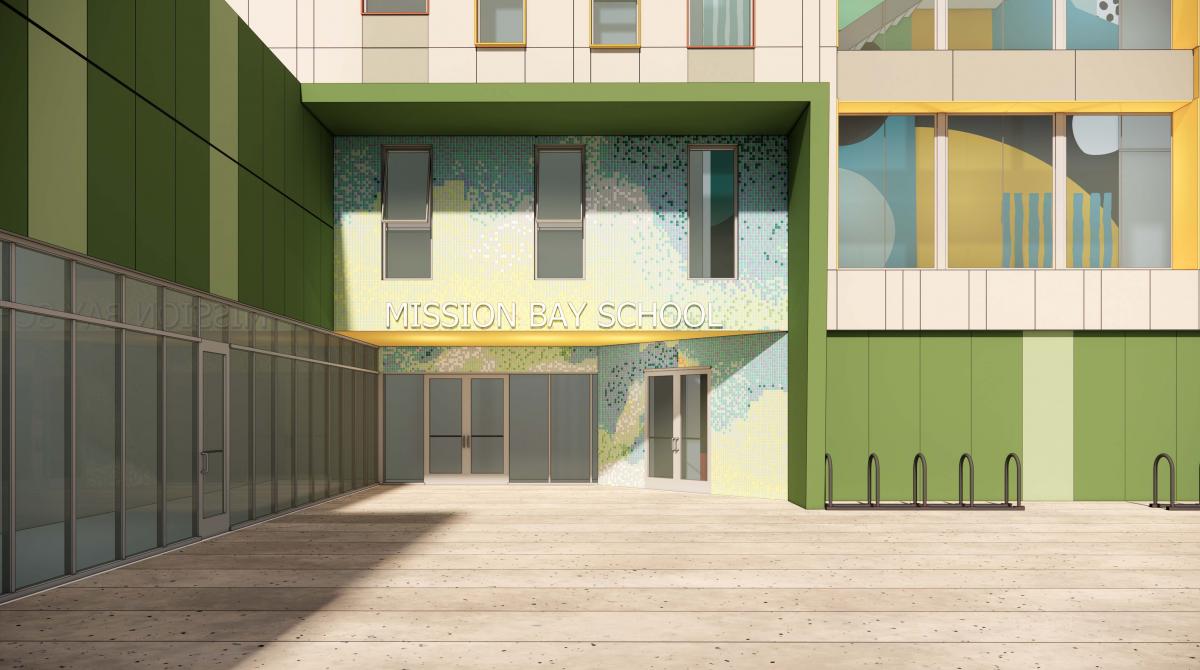

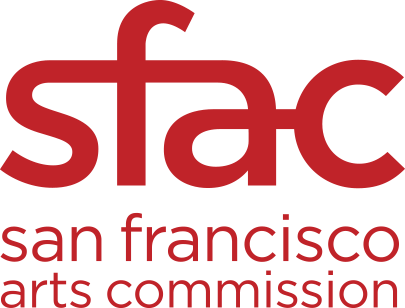

 Intertidal Movements is a large multi-layered tile artwork inspired by the dynamics of the human and natural populations of Mission Bay. It will beautify the east entrance to the new Mission Bay School and illuminate the rich and varied history of the neighborhood, while providing a friendly and welcoming facade for the school’s students, staff, and visitors.
Intertidal Movements is a large multi-layered tile artwork inspired by the dynamics of the human and natural populations of Mission Bay. It will beautify the east entrance to the new Mission Bay School and illuminate the rich and varied history of the neighborhood, while providing a friendly and welcoming facade for the school’s students, staff, and visitors.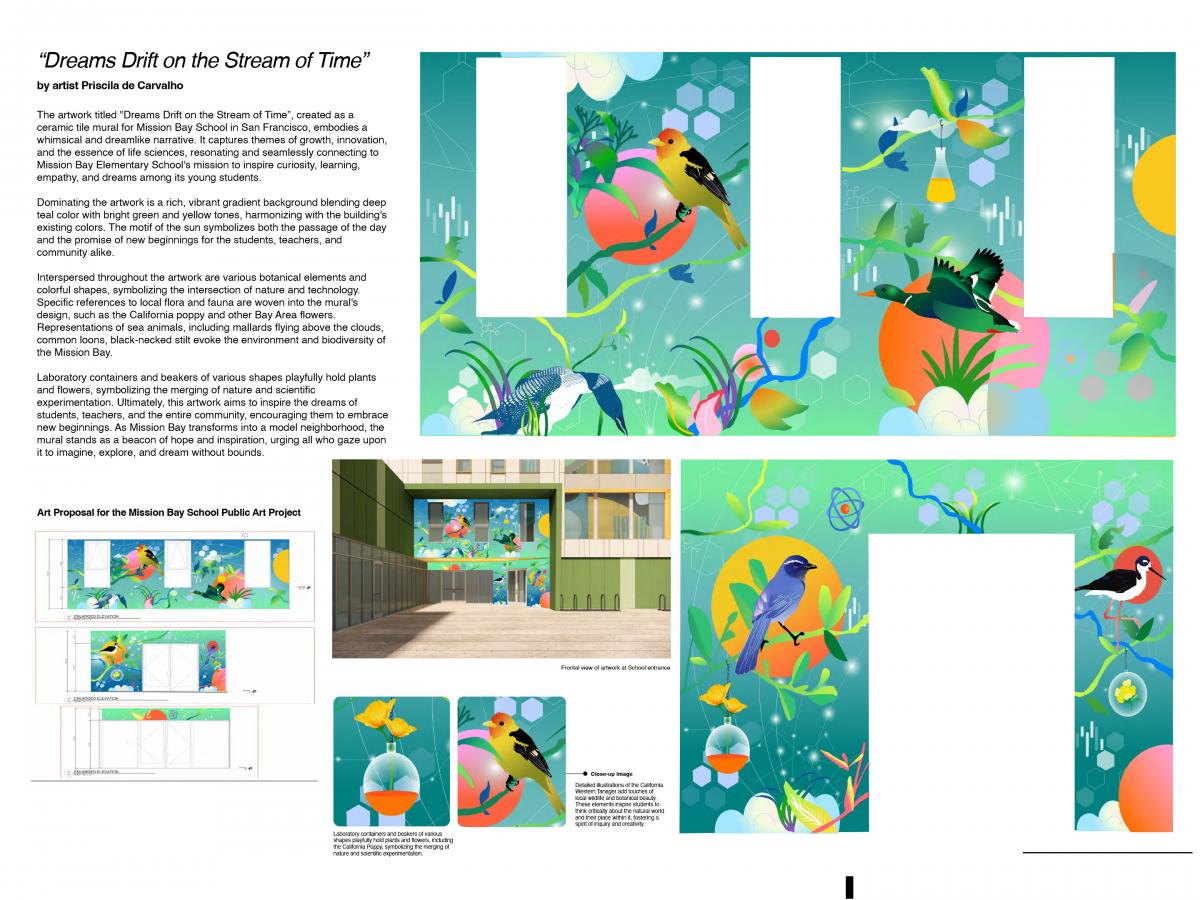 The artwork titled Dreams Drift on the Stream of Time, created as a ceramic mural for Mission Bay School in San Francisco, embodies a whimsical and dreamlike narrative. It captures themes of growth, innovation, and the essence of life sciences, resonating and seamlessly connecting to Mission Bay Elementary School's mission to inspire curiosity, learning, empathy, and dreams among its young students. Dominating the artwork is a rich, vibrant gradient background blending deep teal color with bright green and yellow tones, harmonizing with the building's existing colors. The motif of the sun symbolizes both the passage of the day and the promise of growth and renewal for the Mission Bay neighborhood. Interspersed throughout the artwork are various botanical elements and colorful shapes, symbolizing the intersection of nature and technology. Specific references to local flora and fauna are woven into the mural's design, such as the California poppy and other Bay Area flowers. Representations of sea animals, including mallards flying above the clouds, common loons, black-necked stilt, and many more evoke the environment and biodiversity of the Mission Bay. Laboratory containers and beakers of various shapes playfully hold plants and flowers, symbolizing the merging of nature and scientific experimentation. The presence of hexagonal patterns and molecular structures highlights the mural's connection to the biotech and health hub, showcasing the school's alignment with the community's commitment to advancing scientific research and innovation. These elements inspire students to think critically about the natural world and their place within it, fostering a spirit of inquiry and creativity. Ultimately, this artwork aims to inspire the dreams of students, teachers, and the entire community, encouraging them to embrace new beginnings. As Mission Bay transforms into a model neighborhood, the mural stands as a beacon of hope and inspiration, urging all who gaze upon it to imagine, explore, and dream without bounds.
The artwork titled Dreams Drift on the Stream of Time, created as a ceramic mural for Mission Bay School in San Francisco, embodies a whimsical and dreamlike narrative. It captures themes of growth, innovation, and the essence of life sciences, resonating and seamlessly connecting to Mission Bay Elementary School's mission to inspire curiosity, learning, empathy, and dreams among its young students. Dominating the artwork is a rich, vibrant gradient background blending deep teal color with bright green and yellow tones, harmonizing with the building's existing colors. The motif of the sun symbolizes both the passage of the day and the promise of growth and renewal for the Mission Bay neighborhood. Interspersed throughout the artwork are various botanical elements and colorful shapes, symbolizing the intersection of nature and technology. Specific references to local flora and fauna are woven into the mural's design, such as the California poppy and other Bay Area flowers. Representations of sea animals, including mallards flying above the clouds, common loons, black-necked stilt, and many more evoke the environment and biodiversity of the Mission Bay. Laboratory containers and beakers of various shapes playfully hold plants and flowers, symbolizing the merging of nature and scientific experimentation. The presence of hexagonal patterns and molecular structures highlights the mural's connection to the biotech and health hub, showcasing the school's alignment with the community's commitment to advancing scientific research and innovation. These elements inspire students to think critically about the natural world and their place within it, fostering a spirit of inquiry and creativity. Ultimately, this artwork aims to inspire the dreams of students, teachers, and the entire community, encouraging them to embrace new beginnings. As Mission Bay transforms into a model neighborhood, the mural stands as a beacon of hope and inspiration, urging all who gaze upon it to imagine, explore, and dream without bounds.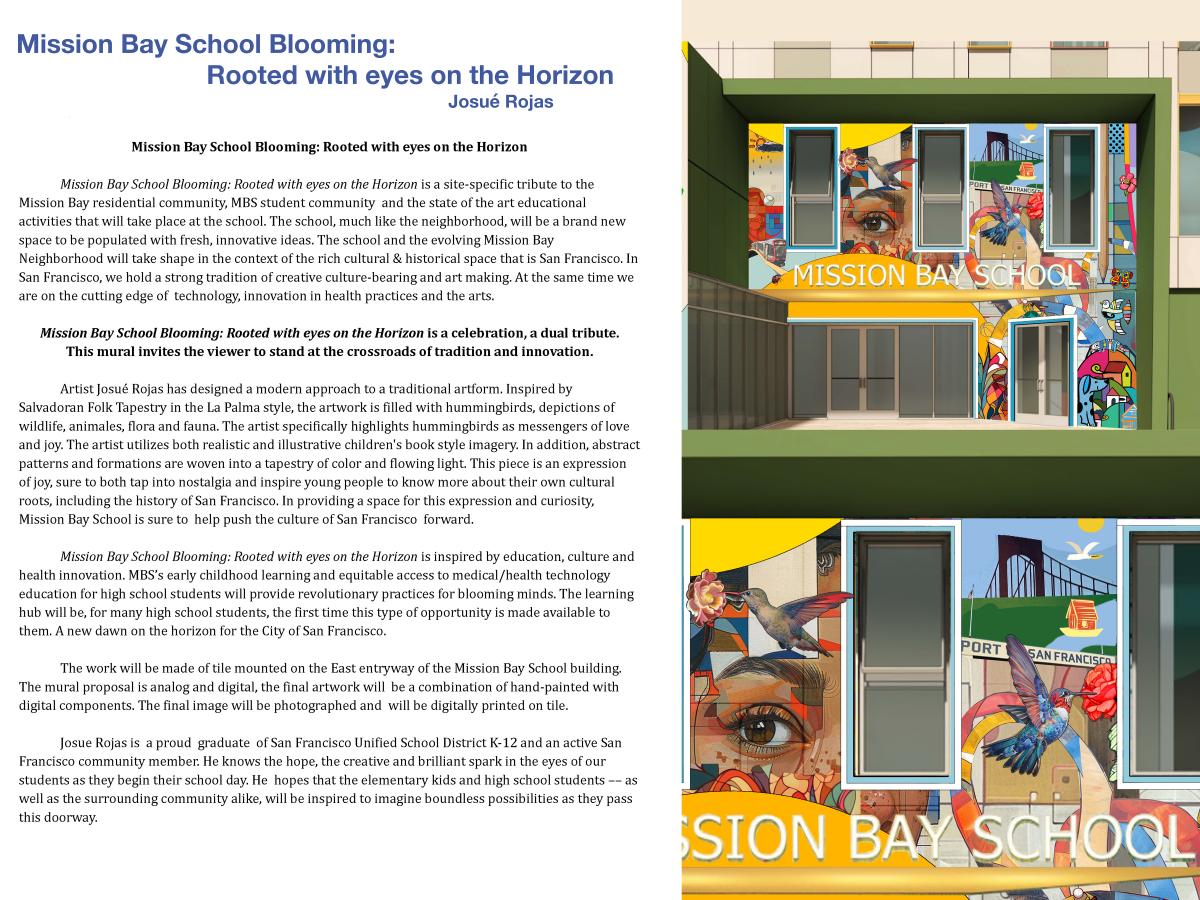 Mission Bay School Blooming: Rooted with Eyes on the Horizon is a site-specific tribute to the Mission Bay residential community, MBS student community and the state of the art educational activities that will take place at the school. The school, much like the neighborhood, will be a brand new space to be populated with fresh, innovative ideas. The school and the evolving Mission Bay Neighborhood will take shape in the context of the rich cultural & historical space that is San Francisco. In San Francisco, we hold a strong tradition of creative culture-bearing and art making. At the same time we are on the cutting edge of technology, innovation in health practices and the arts.
Mission Bay School Blooming: Rooted with Eyes on the Horizon is a site-specific tribute to the Mission Bay residential community, MBS student community and the state of the art educational activities that will take place at the school. The school, much like the neighborhood, will be a brand new space to be populated with fresh, innovative ideas. The school and the evolving Mission Bay Neighborhood will take shape in the context of the rich cultural & historical space that is San Francisco. In San Francisco, we hold a strong tradition of creative culture-bearing and art making. At the same time we are on the cutting edge of technology, innovation in health practices and the arts.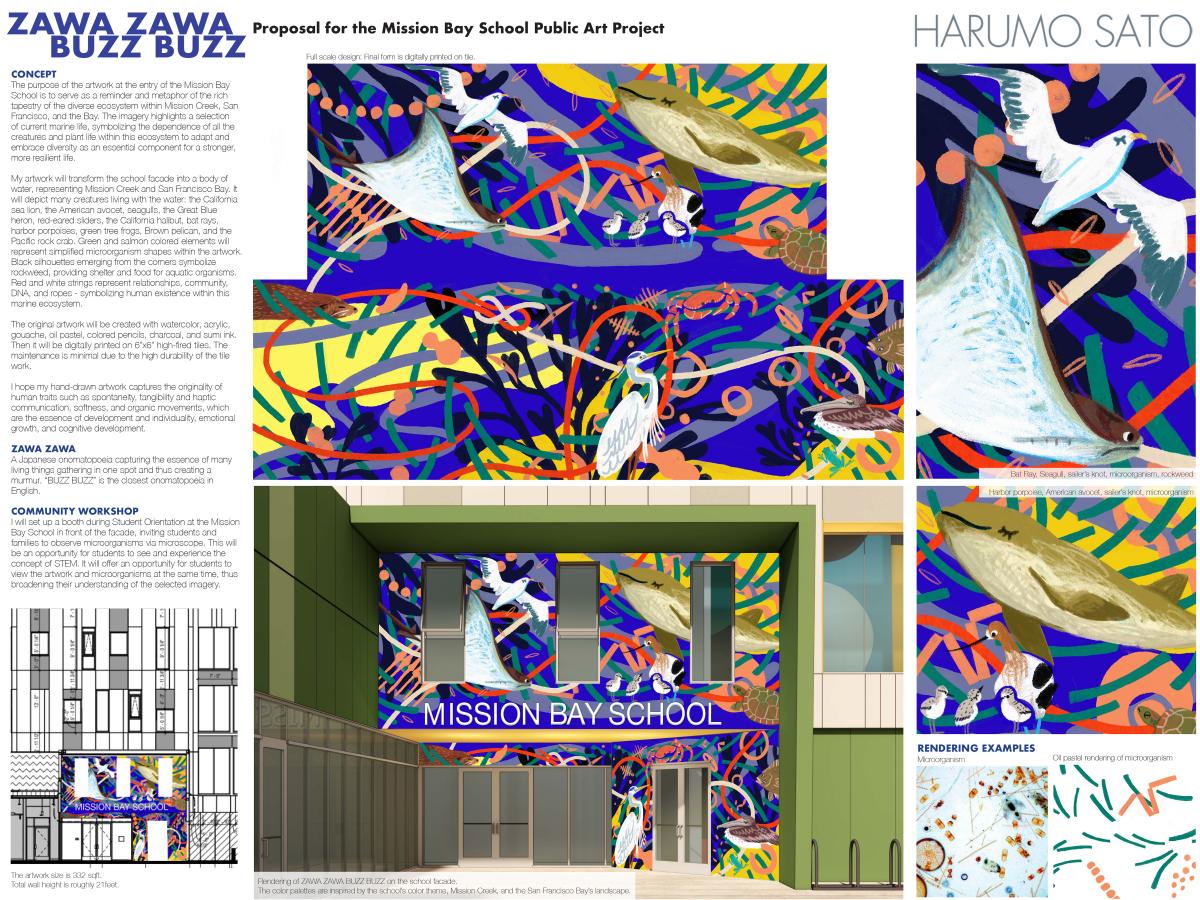 The purpose of the artwork at the entry of the Mission Bay School is to serve as a reminder and metaphor of the rich tapestry of the diverse ecosystem within Mission Creek, San Francisco, and the Bay. The imagery highlights a selection of current marine life, symbolizing the dependence of all the creatures and plant life within this ecosystem to adapt and embrace diversity as an essential component for a stronger, more resilient life.
The purpose of the artwork at the entry of the Mission Bay School is to serve as a reminder and metaphor of the rich tapestry of the diverse ecosystem within Mission Creek, San Francisco, and the Bay. The imagery highlights a selection of current marine life, symbolizing the dependence of all the creatures and plant life within this ecosystem to adapt and embrace diversity as an essential component for a stronger, more resilient life.
Opportunity For Public Comment
Please take a few minutes to review these artwork proposals and provide feedback in the form below. Comments may also be submitted via email to sfacpublicartcomment@sfgov.org by Monday,August 5, 2024 at 5:00 p.m. PST.
Public comments will be considered by the Review Panel as part of the Final Review Panel meeting where the Panel will recommend one proposal for implementation. Please note that public comments do not constitute a vote.
The Final Review Panel meeting will take place remotely the week of August 12, 2024. All Artist Review Panel meetings are open to the public. An agenda for the meeting will be posted 72 hours in advance of the meeting on SFAC’s website under the Public Meeting section: www.sfartscommission.org.